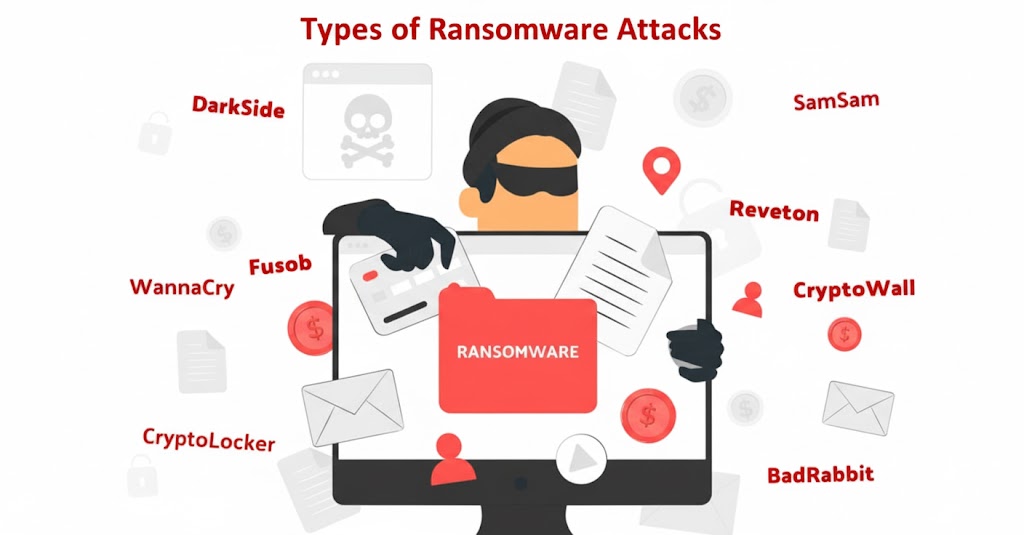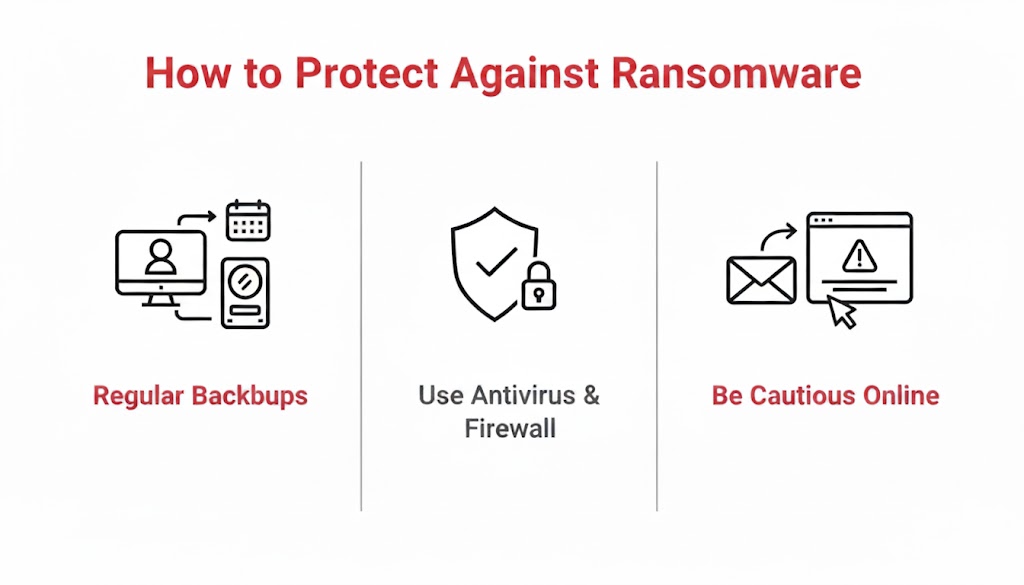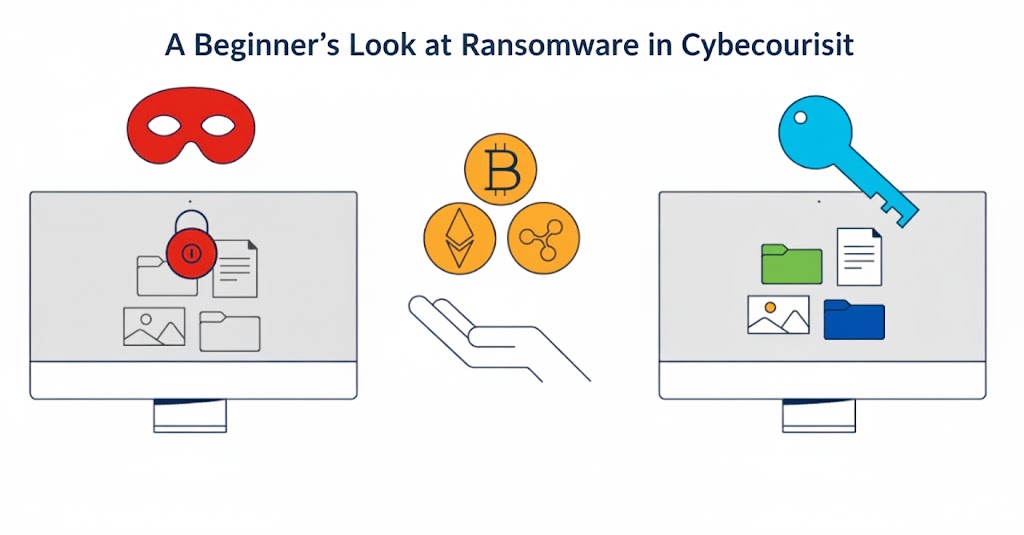Ransomware has become one of the most destructive and costly forms of cyberattacks in today’s digital world. Unlike older malware strains that simply disrupted systems, ransomware locks valuable files or entire networks until a ransom is paid. The frequency of these attacks has surged because cybercriminals now view businesses, government institutions, and even individuals as profitable targets.
Beginners in cybersecurity must understand the basics of ransomware because the risks affect nearly everyone who uses digital devices. From small businesses losing critical data to hospitals being forced offline, ransomware continues to show how vulnerable modern systems are. Even governments and infrastructure providers have faced crippling attacks, highlighting that no sector is completely safe.
What Is Ransomware?
At its simplest, ransomware is malicious software designed to block access to files or systems until the victim pays money to the attacker. Once it infects a system, ransomware either encrypts the files, making them unreadable, or locks the user out entirely.
The attacker then demands payment, usually in cryptocurrency, because digital currencies like Bitcoin are harder to trace. Victims are often promised a decryption key once the ransom is paid, but there is never a guarantee that the criminals will keep their word. Understanding what ransomware is and how it affects businesses is crucial because it not only disrupts operations but also threatens financial stability, customer trust, and long-term reputation. It provides an in-depth look at this threat and its real-world consequences.
How Ransomware Spreads
Cybercriminals use different tactics to spread ransomware. One of the most common is phishing, where attackers send emails with malicious links or attachments disguised as legitimate messages. Once clicked, the malware quietly installs itself and begins its attack.
Another widespread method involves drive-by downloads from unsafe websites. Simply visiting a compromised site may be enough for ransomware to enter a system. Weak passwords and unsecured remote access, such as poorly protected Remote Desktop Protocol (RDP) connections, are also easy entry points for attackers. With more people working remotely, these weaknesses have become more attractive targets.
Types of Ransomware Attacks

Not all ransomware operates in the same way. Crypto ransomware is the most common form, which encrypts valuable files and demands payment for decryption. Locker ransomware, on the other hand, locks the entire system, making it completely unusable until a ransom is paid.
- Ransomware-as-a-Service (RaaS) has emerged.
- This model allows even less-skilled cybercriminals to rent ransomware tools from organized groups, making attacks more frequent and widespread.
- RaaS has fueled a surge in global ransomware campaigns because it lowers the barrier to entry into cybercrime.
The Impact of Ransomware
The impact of ransomware reaches far beyond the initial ransom payment. Businesses often face huge financial losses from downtime, recovery costs, and lost productivity. Rebuilding customer trust after an attack can take years, especially if sensitive data has been exposed.
- Regulatory consequences are also severe. Organizations may face fines under laws like GDPR, HIPAA, or PCI DSS if they fail to protect sensitive data.
- In some cases, ransomware attacks have shut down hospitals, delayed manufacturing operations, and disrupted supply chains, showing just how far-reaching the damage can be.
How to Protect Against Ransomware

Defending against ransomware requires both technology and awareness. Regular updates and patching are critical, as attackers often exploit outdated software. Strong password practices and multi-factor authentication reduce the risk of compromised accounts.
Employees also play a vital role in defense. Since phishing is a leading attack vector, training workers to recognize suspicious emails and avoid unsafe links is essential. Secure browsing practices and regular awareness campaigns can help create a strong culture of cybersecurity.
Backing up data is another crucial strategy. Backups should be stored offline or in secure, isolated environments to ensure attackers cannot encrypt them. When combined with modern tools like Endpoint Detection and Response (EDR) and firewalls, businesses can create multiple layers of protection. For practical tips, resources from CISA provide excellent guidance on prevention and response strategies.
What to Do If You’re Hit by Ransomware
When ransomware strikes, immediate action is necessary. Infected devices should be isolated from the network to prevent further spread. Reporting the attack to relevant authorities is also important, as it helps track criminal groups and prevent future incidents.
Paying the ransom may seem like the easiest way out, but experts strongly discourage it. There is no guarantee that the attacker will provide a decryption key, and paying often encourages more attacks.
Instead, organizations should work with cybersecurity professionals and law enforcement to explore recovery options.
Guidance from the FBI stresses that victims should avoid ransom payments and instead focus on restoration and investigation.
Conclusion
Ransomware is one of the biggest cybersecurity challenges of our time. From crippling global enterprises to targeting small businesses, it has shown the devastating effects of modern cybercrime. Understanding how ransomware works, how it spreads, and how to defend against it is the first step toward building resilience.
Prevention, awareness, and preparation are key. By combining strong defenses, employee education, and recovery planning, individuals and organizations can reduce their risks and protect their futures in a ransomware-filled digital landscape.
FAQs
1. What makes ransomware different from regular malware?
Ransomware is unique because it doesn’t just disrupt systems-it locks or encrypts data and demands payment for its release, often making recovery without backups difficult.
2. Can antivirus software completely stop ransomware?
While antivirus software can detect and block some ransomware, it is not foolproof. A layered defense that includes endpoint detection, firewalls, and user awareness provides stronger protection.
3. Why are small businesses often targeted by ransomware?
Small businesses usually have fewer cybersecurity resources and are more likely to pay ransoms quickly to restore operations, making them attractive targets for attackers.


